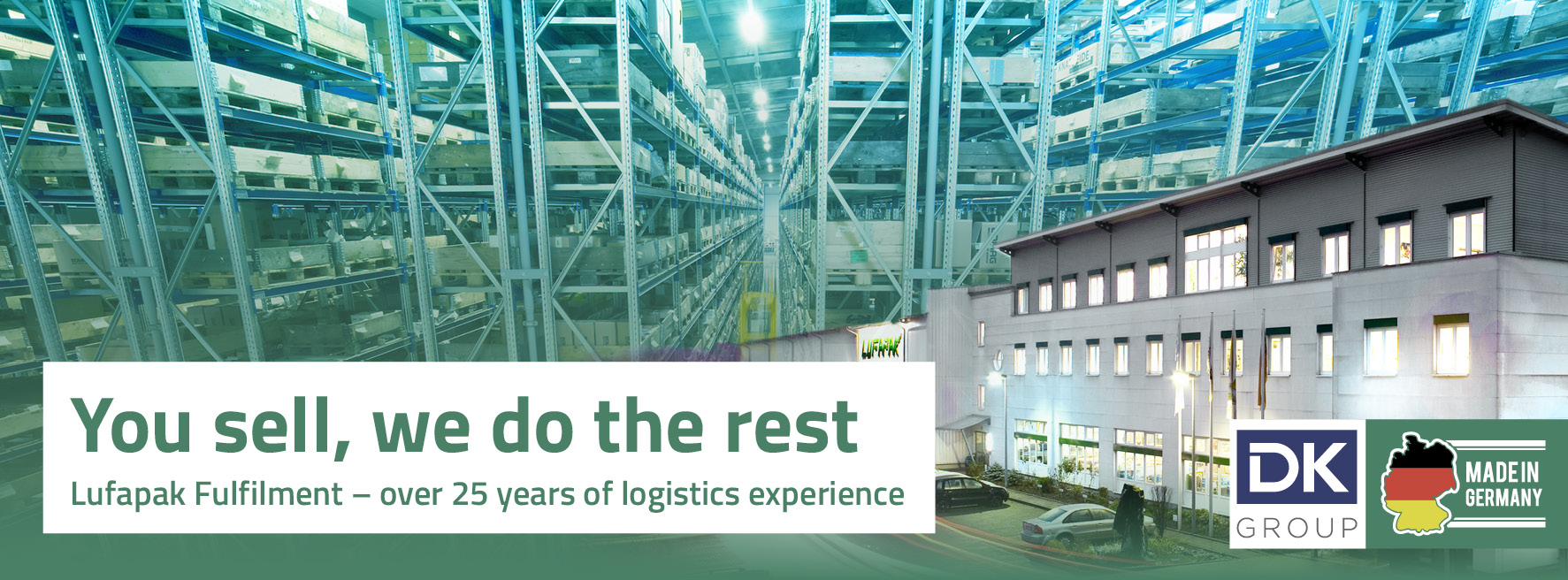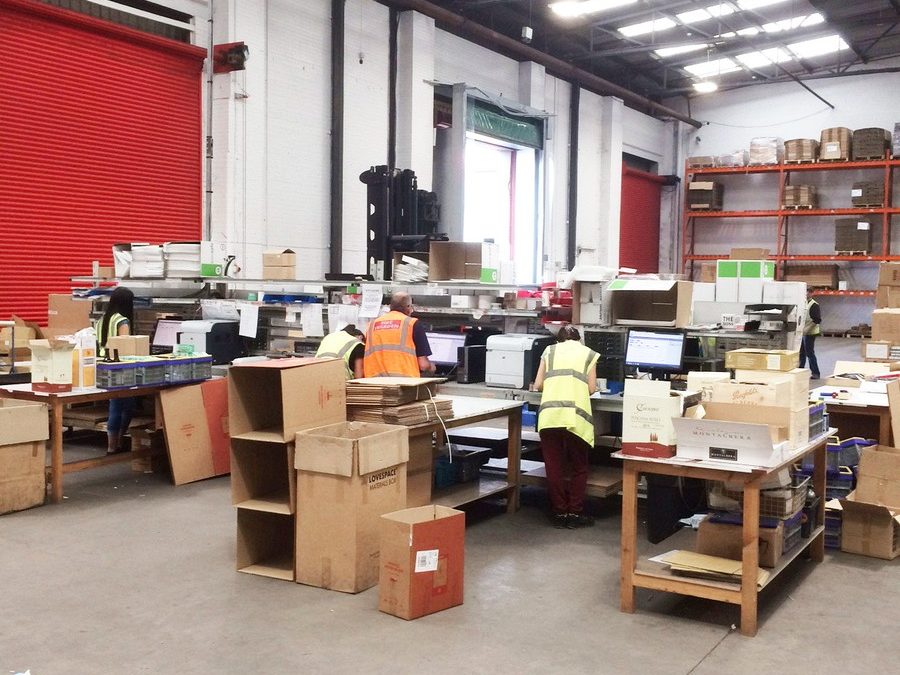sales@lufapak.de +49 2631/384-0 Contactform
What is a flat storage system?
A flat storage system is a type of warehouse characterised by its horizontal structure and ground-level storage. In contrast to high-bay warehouses, which are built vertically upwards, flat storage systems extend mainly in width. This type of warehouse usually consists of large open areas where goods are stored directly on the floor or on low shelves. The main components of a flat storage system are the storage area, racking systems, forklift trucks and other storage technology, as well as areas for incoming and outgoing goods. Flat storage systems offer easy access to the stored goods and thus facilitate handling and order picking, making them particularly suitable for bulky and heavy items.
Advantages of a flat storage system
A flat storage system offers numerous advantages that make it an attractive choice for many companies. One of the outstanding advantages is cost efficiency. Compared to more complex storage structures such as high-bay warehouses, both the construction and operating costs of a flat storage system are significantly lower. The simpler design and lower maintenance costs help to reduce overall costs.
Another decisive advantage is the easy accessibility of the stored goods. As goods are stored at floor level or on low shelves, they are easy to reach. This makes loading, unloading and order picking much easier and therefore reduces the time and effort required to access the stored items.
In addition, a flat storage system offers a high degree of storage flexibility. This type of warehouse is particularly suitable for bulky, heavy or irregularly shaped items that are difficult to store on high shelves or complex storage systems. This flexibility allows companies to store and manage a wide range of products efficiently.
Another advantage is the ability to quickly and easily adapt the layout of a flat storage system to changing requirements. This simple layout customisation allows flexible use of available space and a rapid response to changes in business volume or product mix. This is particularly advantageous in dynamic business environments where requirements can change frequently.

The relatively low technical requirements are another plus point. Flat storage often requires less specialised storage technology and equipment, which further reduces investment and operating costs. Finally, horizontal storage without high racking helps to reduce the risk of accidents caused by falling goods, which improves safety in the warehouse.
Areas of application for flat storage systems
Flat storage systems are used in a variety of industries and offer flexible storage solutions for different needs. In retail, flat storage is particularly valuable as it enables efficient storage and quick access to goods. Retailers benefit from the ability to store seasonal products, promotional items and bulky or voluminous items easily and clearly. Direct accessibility also makes it easier to replenish sales areas quickly and thus contributes to smooth business operations.
In industry, flat storage systems play a decisive role in the storage of raw materials, semi-finished and finished products. Due to their flexibility, flat storage systems can be easily adapted to the specific requirements of different production processes. Industrial companies appreciate the ability to store heavy and bulky machine components safely and efficiently without the need for complex racking systems. This enables uncomplicated handling and quick access to the required materials, which increases efficiency in production.
Flat storage systems also offer considerable advantages in production. Manufacturing facilities utilise flat storage to store intermediate products, tools and end products. This form of storage enables seamless integration into the production process as it is flexible in design and easily accessible. This minimises the time required for handling and transporting materials within production and increases the overall efficiency of production processes.
In addition, flat storage systems also have a wide range of applications in other sectors such as wholesale, construction and logistics. In wholesale, they facilitate the handling of large order volumes and the rapid processing of orders. In the construction industry, they serve as flexible storage areas for building materials and equipment, which often have irregular shapes and sizes. In the logistics sector, they support the efficient distribution and storage of goods of different types and sizes.
Planning and construction of a flat storage facility
The planning and construction of a flat storage facility requires a careful approach to ensure that the warehouse can be operated efficiently and cost-effectively. The process begins with site selection, which is crucial. An ideal location should be well connected to the transport network, including motorways, railways and, where appropriate, ports or airports. Proximity to suppliers and customers also plays an important role in minimising transport costs and shortening delivery times.
Once the location has been determined, the next step is to plan the construction of the flat storage facility. This includes designing the layout, which should be as flexible and adaptable as possible. Storage zones for different types of goods, routes for transporting goods and areas for incoming and outgoing goods must be planned. The design should also take safety aspects into account, such as sufficient lighting, ventilation and fire protection measures. It is also important to plan sufficient space for future expansions.
An essential step in the planning process is the selection of technological requirements. Even though flat storage facilities generally require less technological equipment than high-bay warehouses, some technologies are still indispensable. For example, forklift trucks or pallet trucks are necessary to move heavy and bulky goods. In modern flat warehouses, the use of warehouse management software can also be useful to monitor stock levels and optimise warehouse processes. This software helps to keep track of stored goods, manage stock levels and increase the efficiency of warehouse processes.
After planning and defining the technological requirements, the actual construction of the flat storage facility follows. This includes the construction of the warehouse, the installation of the necessary infrastructure such as racking systems and the provision of storage technology. During this process, it is important that all construction and installation work complies with the applicable regulations and safety standards.
Once the warehouse is built, a test phase should be carried out to ensure that all systems and processes are running smoothly. This includes checking the warehouse management software, training staff to use the new equipment and carrying out trial runs for typical warehouse processes such as goods in, storage, picking and goods out.
Safety aspects in flat storage facilities
Safety plays a central role in the planning and operation of a flat storage facility. In order to protect both employees and the stored goods, various safety measures must be carefully implemented and continuously monitored.
One important aspect is occupational safety. This includes ensuring that all employees undergo regular training on safety guidelines and procedures. Clear instructions should be in place for the safe handling of warehouse equipment such as forklift trucks and pallet trucks. Personal protective equipment (PPE) such as safety shoes, helmets and gloves are mandatory for all employees, especially when handling heavy or bulky goods.
Fire safety measures are another critical safety area. The warehouse should be equipped with sufficient fire extinguishers, smoke detectors and sprinkler systems. Escape routes and emergency exits must be clearly marked and freely accessible at all times. Regular fire drills help employees to react quickly and correctly in the event of an emergency. It is also important that flammable materials are stored safely and kept away from sources of ignition.
The storage structure itself must also be designed safely. Racking systems should be stable and properly installed to minimise the risk of collapse. If necessary, protective devices such as edge and corner protectors must be installed in high-traffic areas. Floor conditions also play a role: non-slip floors and well-marked traffic routes can prevent accidents.
To increase the security of stored goods, it makes sense to utilise modern security technologies such as surveillance cameras and access control systems. These measures help to prevent theft and vandalism. In addition, a reliable alarm system should be installed that reacts immediately in the event of a break-in or other threat.
Ergonomic measures also contribute to security. Workstations and processes should be designed to minimise physical strain. Lifting aids and ergonomically designed work equipment can help to prevent injuries caused by incorrect lifting and moving of heavy loads.
Regular maintenance and inspection of warehouse infrastructure and technology are essential in order to recognise and eliminate hazards at an early stage. This includes checking the stability and functionality of racking systems, maintaining forklift trucks and other machinery and checking lighting and ventilation systems.
Finally, a comprehensive **emergency management** system should be in place. This includes clear plans and procedures for various emergency scenarios such as fires, accidents or natural disasters. All employees should be familiar with these plans and know how to act in the event of an emergency.
Maintenance and operation of a flat storage facility
The efficient and safe operation of a flat storage facility requires continuous maintenance and well thought-out operational processes. Regular maintenance work is crucial to ensure the functionality of the warehouse infrastructure and to recognise and eliminate potential safety risks at an early stage.
A central component of maintenance work is the inspection of the storage facility. This includes checking the stability and integrity of the racking systems and the general warehouse structure. If any damage or signs of wear are detected, these must be repaired immediately to minimise the risk of accidents. Floors should also be checked regularly for cracks or other damage and repaired if necessary to avoid the risk of falls.
The maintenance of storage technology is just as important. Forklift trucks, pallet trucks and other lifting and conveying equipment must be checked and serviced regularly. In particular, the brakes, steering, hydraulic systems and safety devices should be carefully inspected. Regular maintenance intervals ensure that this equipment is always ready for use and safe.
Well-functioning lighting and ventilation in the warehouse is essential for the safety and well-being of employees. All lighting equipment should be cleaned regularly and defective lamps replaced immediately. Ventilation systems must also be regularly checked and maintained to ensure adequate air circulation and quality.
Safety measures such as fire drills and regular safety inspections also contribute to the efficiency and safety of warehouse operations. All employees should be regularly trained in the applicable safety regulations and know how to react in an emergency.
Contact us now and get advice


